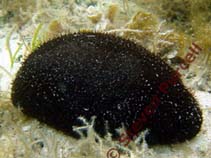Actinopyga miliaris (Quoy & Gaimard, 1833)
Hairy blackfish| Native range | All suitable habitat | Point map | Year 2050 |

|
| This map was computer-generated and has not yet been reviewed. |
| Actinopyga miliaris AquaMaps Data sources: GBIF OBIS |
Classification / Names Common names | Synonyms | CoL | ITIS | WoRMS
Holothuroidea | Holothuriida | Holothuriidae
Environment: milieu / climate zone / depth range / distribution range Ecology
Reef-associated; depth range 0 - 20 m (Ref. 122), usually 0 - 12 m (Ref. 92930). Tropical; 30°N - 28°S, 32°E - 134°W
Distribution Countries | FAO areas | Ecosystems | Occurrences | Introductions
Indo- Pacific, including the Red Sea, but excluding the Persian Gulf and Hawaii.
Length at first maturity / Size / Weight / Age
Maturity: Lm ? range ? - ? cm Max length : 35.0 cm TL male/unsexed; (Ref. 122); common length : 25.0 cm TL male/unsexed; (Ref. 122); max. published weight: 2.0 kg (Ref. 418)
Short description Morphology
Body Width: 10 cm. Body thickness: 0.9 cm (Ref. 418); 6mm (Ref. 122). Body elongate, cylindrical, slightly arched dorsally (bivium) and flattened ventrally (trivium). Bivium covered by mucus and fine sediment. Papillae on bivium numerous, long and slender; long and thick podia on trivium arranged more or less regularly in tight rows on the radii; calcareous disc of podia around 700 micrometer in diameter. Mouth ventral, surround by 20 stout tentacles. Anus surrounded by 5 strong, triangular anal teeth. Calcareous ring with large radial pieces and narrow interradials. Cuvierian tubules absent. Color of bivium black; trivium lighter, dark brown. Spicules on ventral tegument with variety of simple or more complicated rosettes; dorsal tegument with rosette; ventral and dorsal podia with some rosettes; podia and papillae containing large spicules; tentacles with large rods.
Biology poorly known. Harvested by artisanal fisheries throughout the area. Collected by hand while wading on the reefs at low tide, or by divers. Processed product is not distinguished from those of other Actinopyga species; moderate commercial value. Maximum depth from Ref. 92930. Dwelling in moderately shallow waters; mostly on reef flats of fringing and lagoon-islet reefs, never on barrier reefs; common in sandy beds (Ref. 92930) and abundant in seagrass beds and on rubble reef flats where populations can reach high densities up to 1 square meter (Ref. 122). Feeds mainly on epiphytes and seagrass leaves (Ref. 122). Gregarious in nature (Ref. 118). Found in waters less than 30m, among rocks and boulders (Ref. 129602).
Life cycle and mating behavior Maturity | Reproduction | Spawning | Eggs | Fecundity | Larvae
Main reference
References | Coordinator | Collaborators
Conand, C. 1998. (Ref. 122)
IUCN Red List Status (Ref. 130435)
Vulnerable (VU) (A2bd); Date assessed: 15 May 2010
CITES status (Ref. 108899)
Not Evaluated
CMS (Ref. 116361)
Not Evaluated
Threat to humans
Harmless
Human uses
Fisheries: commercial
| FishSource |
Tools
More information
Internet sources
BHL | BOLD Systems | CISTI | DiscoverLife | FAO(Publication : search) | Fishipedia | GenBank (genome, nucleotide) | GloBI | Gomexsi | Google Books | Google Scholar | Google | PubMed | Tree of Life | Wikipedia (Go, Search) | Zoological Record
Estimates based on models
Preferred temperature
(Ref. 115969): 25.2 - 29.3, mean 28.5 (based on 3470 cells).
Price category
(Ref. 80766):
Unknown.



